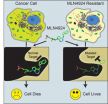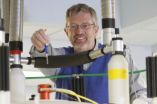(Press-News.org) LA JOLLA, Calif., March 19, 2012 – Drug resistance is a serious problem for cancer patients—over time, a therapy that was once providing some benefit simply stops working. Scientists at Sanford-Burnham Medical Research Institute (Sanford-Burnham) recently discovered how cancer cells develop resistance to a drug called MLN4924. This experimental therapy is currently being tested in a number of Phase I and Phase I/II clinical trials to determine its efficacy against several different types of cancer, including multiple myeloma, leukemia, and lymphoma.
Published online March 19 by Cell Reports, the study shows that MLN4924-resistant cancer cells escape death because they have a simple mutation in the drug's target—NEDD8-activating enzyme—that prevents the drug from binding. In unraveling this mechanism, the researchers also developed a relatively quick, low-cost laboratory method that can be used to personalize cancer therapies by predicting how cancer patients will respond to this or other drugs—all before a person starts taking it.
"Due to genetic variability, some tumors might be more prone to developing resistance to treatment than others. Pinpointing the right treatment for an individual can be a frustrating and costly trial-and-error process. The method we developed in this study to determine the mechanism of resistance for one anti-cancer drug gives us a jumpstart on knowing if this resistance mechanism will hold true for other drugs—potentially saving time and money," said Matthew Petroski, Ph.D., assistant professor in Sanford-Burnham's National Cancer Institute-designated Cancer Center and senior author of the study.
MLN4924: Promising anti-cancer drug
MLN4924 kills most cancer cells by binding and inactivating the NEDD8-activating enzyme. NEDD8 and the enzymes that control it are part of the ubiquitin proteasome system (so-named because it's ubiquitous, found in every cell in the body).
This complex network of enzymes tags proteins with a molecule called ubiquitin. Once it receives this "kiss of death," a protein is destined for the proteasome, the cell's "meat grinder." Depending on which proteins are being destroyed, this process helps control almost every aspect of cellular function and is frequently altered in cancer.
When MLN4924 shuts down NEDD8, a critical part of the ubiquitin proteasome system malfunctions and instead of continuing to proliferate, cancer cells die.
According to Petroski, finding new ways to target the ubiquitin proteasome system and prevent it from chewing up key proteins is a promising research area that might lead to powerful new anti-cancer therapeutics.
How cancer cells escape MLN4924
Petroski and his laboratory, including the study's first author, researcher Julia Toth, Ph.D., discovered that MLN4924 kills more than 99 percent of cancer cells in laboratory tests. Yet a small population survives.
In that small but important population of MLN4924-resistant cells, Petroski's team found a mutation in the NEDD8-activating enzyme. With just a single change in a single nucleotide in the gene that encodes this enzyme, the cells were able to survive.
"Gleevec and other cancer drugs that work by binding and inactivating kinases—another class of enzymes—also lose their potency when their target proteins mutate. But this is the first time such a mechanism has been identified for a drug that targets an enzyme of the ubiquitin proteasome system," Petroski said.
Understanding how cancer cells manage to avoid death at the hands of MLN4924 provides clues as to how scientists might improve it or other drugs that target the ubiquitin proteasome system in a way that makes them more effective. In addition to further developing their laboratory test to determine a drug's efficacy, Petroski and his team are now leveraging this knowledge to find new anti-cancer drugs—particularly drugs that can circumvent this newly discovered resistance mechanism.
INFORMATION:
This research was funded by a Sanford-Burnham start-up fund, the American Cancer Society, and the V Foundation for Cancer Research. The study's co-authors include Julia I. Toth, Li Yang, Russell Dahl, and Matthew D. Petroski.
About Sanford-Burnham Medical Research Institute
Sanford-Burnham Medical Research Institute is dedicated to discovering the fundamental molecular causes of disease and devising the innovative therapies of tomorrow. The Institute consistently ranks among the top five organizations worldwide for its scientific impact in the fields of biology and biochemistry (defined by citations per publication) and currently ranks third in the nation in NIH funding among all laboratory-based research institutes. Sanford-Burnham is a highly innovative organization, currently ranking second nationally among all organizations in capital efficiency of generating patents, defined by the number of patents issued per grant dollars awarded, according to government statistics.
Sanford-Burnham utilizes a unique, collaborative approach to medical research and has established major research programs in cancer, neurodegeneration, diabetes, and infectious, inflammatory, and childhood diseases. The Institute is especially known for its world-class capabilities in stem cell research and drug discovery technologies. Sanford-Burnham is a U.S.-based, non-profit public benefit corporation, with operations in San Diego (La Jolla) and Santa Barbara, California and Orlando (Lake Nona) in Florida. For more information, please visit our website (www.sanfordburnham.org) or blog (http://beaker.sanfordburnham.org). You can also receive updates by following us on Facebook and Twitter.
Sanford-Burnham scientists unravel cancer drug's secret to resistance
Study outlines new method to test a tumor's resistance to an experimental therapy and pinpoint the genetic culprit before testing the drug in patients—providing a new path toward personalized medicine
2012-03-20
ELSE PRESS RELEASES FROM THIS DATE:
Solving the mystery of blood clotting
2012-03-20
How and when our blood clots is one of those incredibly complex and important processes in our body that we rarely think about. If your blood doesn't clot and you cut yourself, you could bleed to death, if your blood clots too much, you could be in line for a heart attack or stroke. Dr. Hans Vogel, a professor at the University of Calgary, has thought a lot about blot clotting and recently published research in the prestigious Journal of the American Chemical Society that helps to better understand the clotting process.
Vogel and his graduate student Hao Huang were able ...
Smell is a symphony
2012-03-20
Just like a road atlas faithfully maps real-word locations, our brain maps many aspects of our physical world: Sensory inputs from our fingers are mapped next to each other in the somatosensory cortex; the auditory system is organized by sound frequency; and the various tastes are signaled in different parts of the gustatory cortex.
The olfactory system was believed to map similarly, where groups of chemically related odorants - amines, ketones, or esters, for example - register with clusters of cells that are laid out next to each other.
When researchers at the Stowers ...
Scientists develop a software tool for estimating heart disease risk
2012-03-20
University of Granada researchers have developed a software tool that makes an accurate estimation of the risk that a person has to suffer a heart disease. In addition, this software tool allows the performance of massive risk estimations, i.e. it helps estimating the risk that a specific population group has of suffering a heart condition. The researchers employed a sample including 3 000 patients.
Heart conditions increasingly affect working age population, which can make individuals loss potential years of work and productivity.
Understanding the risk for ...
Empowered citizens or hopeful bystanders?
2012-03-20
The new political appetite for 'localism' in town planning has triggered anxiety within local communities and amongst those charged with making it work, according to new research funded by the Economic and Social Research Council (ESRC).
A study led by Professor Nick Gallent of the Bartlett School of Planning, University College London, looked at how communities in Kent have sought to influence the policies of local authorities and service providers and how, in the recent past, they have engaged with planning professionals around the production of 'parish plans'. The ...
First complete full genetic map of promising energy crop
2012-03-20
Researchers in Wales and the United States have collaborated to complete the first high-resolution, comprehensive genetic map of a promising energy crop called miscanthus. The results – published in the current edition of the peer-reviewed, online journal PLoS One – provide a significant breakthrough towards advancing the production of bioenergy.
The breakthrough results from the long-term collaboration between energy crop company Ceres, Inc., based in Thousand Oaks, California, USA, and the Institute of Biological, Environmental and Rural Sciences (IBERS) at Aberystwyth ...
Lifestyle study highlights key differences in relapsing and progressive onset MS
2012-03-20
Patients with relapsing onset Multiple Sclerosis (MS) who consumed alcohol, wine, coffee and fish on a regular basis took four to seven years longer to reach the point where they needed a walking aid than people who never consumed them. However the study, published in the April issue of the European Journal of Neurology, did not observe the same patterns in patients with progressive onset MS.
The authors say that the findings suggest that different mechanisms might be involved in how disability progresses in relapsing and progressive onset MS.
Researchers asked patients ...
Scientists develop tools to make more complex biological machines from yeast
2012-03-20
Scientists are one step closer to making more complex microscopic biological machines, following improvements in the way that they can "re-wire" DNA in yeast, according to research published today in the journal PLoS ONE.
The researchers, from Imperial College London, have demonstrated a way of creating a new type of biological "wire", using proteins that interact with DNA and behave like wires in electronic circuitry. The scientists say the advantage of their new biological wire is that it can be re-engineered over and over again to create potentially billions of connections ...
Researchers develop blueprint for nuclear clock accurate over billions of years
2012-03-20
A clock accurate to within a tenth of a second over 14 billion years – the age of the universe – is the goal of research being reported this week by scientists from three different institutions. To be published in the journal Physical Review Letters, the research provides the blueprint for a nuclear clock that would get its extreme accuracy from the nucleus of a single thorium ion.
Such a clock could be useful for certain forms of secure communication – and perhaps of greater interest – for studying the fundamental theories of physics. A nuclear clock could be as much ...
Soy-based S-equol supplement reduces metabolic syndrome risk factors
2012-03-20
Washington, DC. (March 19, 2012) – A 12-week treatment of the fermented soy germ-based nutritional supplement containing S-equol significantly lowered hemoglobin A1c (HbA1c), LDL cholesterol and improved vascular stiffness, all factors that occur as part of metabolic syndrome, according to a first-of-its-kind peer-reviewed study reported in a poster at the Women's Health 2012 annual meeting.
"This study is the first to provide evidence that a daily supplement of soy-based S-equol favorably change metabolic syndrome risk factors, particularly in women. Because not all ...
Study: Including ads in mobile apps poses privacy, security risks
2012-03-20
Researchers from North Carolina State University have found that including ads in mobile applications (apps) poses privacy and security risks. In a recent study of 100,000 apps in the official Google Play market, researchers noticed that more than half contained so-called ad libraries. And 297 of the apps included aggressive ad libraries that were enabled to download and run code from remote servers – which raises significant privacy and security concerns.
"Running code downloaded from the Internet is problematic because the code could be anything," says Dr. Xuxian Jiang, ...
LAST 30 PRESS RELEASES:
New software sheds light on cancer’s hidden genetic networks
UT Health San Antonio awarded $3 million in CPRIT grants to bolster cancer research and prevention efforts in South Texas
Third symposium spotlights global challenge of new contaminants in China’s fight against pollution
From straw to soil harmony: International team reveals how biochar supercharges carbon-smart farming
Myeloma: How AI is redrawing the map of cancer care
Manhattan E. Charurat, Ph.D., MHS invested as the Homer and Martha Gudelsky Distinguished Professor in Medicine at the University of Maryland School of Medicine
Insilico Medicine’s Pharma.AI Q4 Winter Launch Recap: Revolutionizing drug discovery with cutting-edge AI innovations, accelerating the path to pharmaceutical superintelligence
Nanoplastics have diet-dependent impacts on digestive system health
Brain neuron death occurs throughout life and increases with age, a natural human protein drug may halt neuron death in Alzheimer’s disease
SPIE and CLP announce the recipients of the 2025 Advanced Photonics Young Innovator Award
Lessons from the Caldor Fire’s Christmas Valley ‘Miracle’
Ant societies rose by trading individual protection for collective power
Research reveals how ancient viral DNA shapes early embryonic development
A molecular gatekeeper that controls protein synthesis
New ‘cloaking device’ concept to shield sensitive tech from magnetic fields
Researchers show impact of mountain building and climate change on alpine biodiversity
Study models the transition from Neanderthals to modern humans in Europe
University of Phoenix College of Doctoral Studies releases white paper on AI-driven skilling to reduce burnout and restore worker autonomy
AIs fail at the game of visual “telephone”
The levers for a sustainable food system
Potential changes in US homelessness by ending federal support for housing first programs
Vulnerability of large language models to prompt injection when providing medical advice
Researchers develop new system for high-energy-density, long-life, multi-electron transfer bromine-based flow batteries
Ending federal support for housing first programs could increase U.S. homelessness by 5% in one year, new JAMA study finds
New research uncovers molecular ‘safety switch’ shielding cancers from immune attack
Bacteria resisting viral infection can still sink carbon to ocean floor
Younger biological age may increase depression risk in older women during COVID-19
Bharat Innovates 2026 National Basecamp Showcases India’s Most Promising Deep-Tech Ventures
Here’s what determines whether your income level rises or falls
SCIE indexation achievement: Celebrate with Space: Science & Technology
[Press-News.org] Sanford-Burnham scientists unravel cancer drug's secret to resistanceStudy outlines new method to test a tumor's resistance to an experimental therapy and pinpoint the genetic culprit before testing the drug in patients—providing a new path toward personalized medicine



